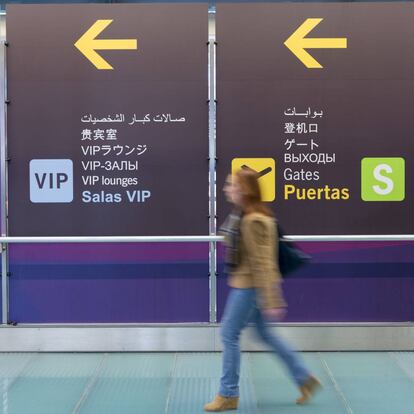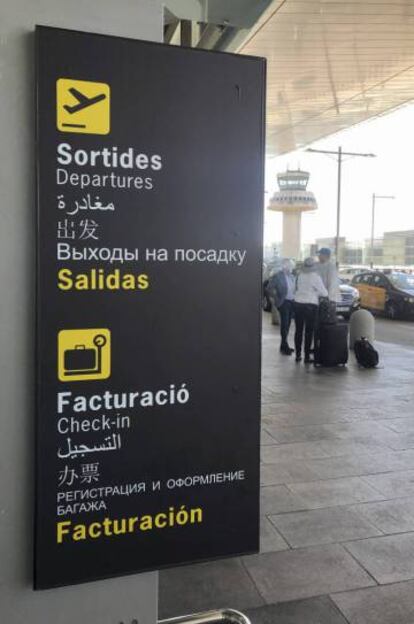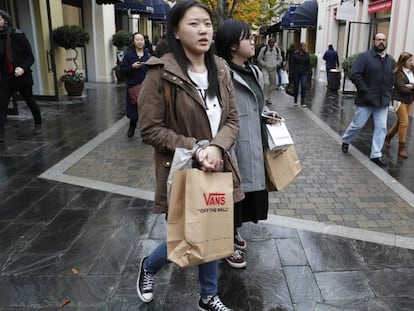Hot water and a phoenix: How Madrid airport is catering to Chinese tourists
Travel authorities are preparing a series of changes, including new food menus and mobile payments, to make these highly valued visitors “feel at home”


Madrid-Barajas airport has begun working on a plan to better accommodate Chinese tourists. The reason is simple: China is the biggest source of tourists in the world, with around 130 million Chinese citizens traveling abroad every year.
Under the plan, which hasn’t yet been made public, the airport will work with the consultancy firm Henkuai to make its services and facilities as welcoming as possible to Chinese travelers.
Communication is key, without that they’ll feel lost Carlos Sentís, general director of Henkuai
“We are carrying out a series of refurbishments to cover their specific needs. They are highly valued visitors because of their growth potential and high spending,” explains a spokesperson from the Spanish airport authority AENA.
One of the main goals of the plan is to show Chinese tourists that they can find all the luxury brands that they like at Madrid-Barajas airport, as well as food from their region. Indeed, all the food offered in the airport terminal will be reviewed to make sure it’s to their liking.
Another key issue is technology. Mobile payments are very popular in China. Young people rarely leave the house with a wallet. They don’t need it. That’s why luxury brands like Loewe, Lagardère and Dufry in the airport accept Chinese tourists’ preferred payment method: WeChat Pay, a multi-purpose messaging, social media and mobile payment app. Henkuai has also recommended accepting other forms of payment like AliPay, a mobile payment platform or UnionPay, a local bank card.

“If they want to attract Chinese tourists they have to optimize Chinese tourism. This doesn’t happen just by translating the signs and menus. You have to have Chinese workers in the shops, hotel receptionists should speak Chinese, tour guides as well. Communication is key, without that they’ll feel lost. If we want to attract them, we have to accept their differences and make their experience here as comfortable as possible,” explains Carlos Sentís, general director of Henkuai, the leading consultancy firm on Spanish-Chinese relations.
The airport’s plan is nothing new to Spain, which after France receives the highest number of tourists in the world: 82.8 million in 2018. Ever since Britons, Americans and Canadians started to visit the country, attracted by the legendary stories of writers Gerald Brenan and Ernest Hemingway, Spain has adapted its customs to please Anglo visitors. An English-speaking tourist can spend weeks in the country without speaking a single word of Spanish. Hotels, restaurants and activities are designed exclusively for them. Coastal hotels open their dinner buffets at 6pm, when some Spaniards are still digesting lunch. Tourists can then play a game of pool or darts at the bar, while having a pint.
A similar transformation is happening at Madrid-Barajas airport to make sure Chinese visitors “feel at home,” says AENA. The first step was to introduce a space exclusively for Chinese food in the VIP lounges. That’s going to be expanded so that hot Chinese food carts will be at the boarding gates of airlines that fly to China. Water fountains with boiling water will also be placed in these areas so passengers can prepare tea and noodles, or simply have a drink, since the Chinese believe cold water is bad for the stomach, especially in the early hours of the morning.
We have to be more persuasive and make them see that they’re going to love it here Carlos Sentís, general director of Henkuai
But how will Chinese tourists know that the red carpet is being rolled out for them? AENA has created a profile on WeChat, but the account has yet to prosper. AENA’s encountered similar problems with its profile on Xiaohongshu, the Chinese social network with the second-highest number of users, more than 200 million.
Margaret Chen, founder of China Club Spain, a not-for-profit organization for Chinese professionals, welcomes these small changes. But while she says they are a good start, she believes there is a lot more room for improvement. Spain only receives 800,000 Chinese visitors per year, and many of them arrive via France. “If they enter via France and leave via France, they shop in France. These are the little things you have to know. For example, it takes 72 hours to get the visa for Spain. In France they give it to you in 24 hours. When it comes to choosing, they’ll go with that option,” says Chen in a phone interview.
The competition between countries to attract Chinese tourists is fierce. “Chinese tourists spend the most by far. Countries fight to please them. It’s difficult to win their attention because they are bombarded with advertisements. Spain is in fashion, it sounds familiar to them, but we have to be more persuasive and make them see that they’re going to love it here,” says Sentís, who has been organizing campaigns to attract Chinese tourists for years. The most important initiatives involve Chinese social media influencers, who have great prestige in a country where the media is heavily restricted by the government.
Chinese tourists typically organize trips to Madrid, Barcelona and Seville, but they have shown growing interest in Granada, Valencia and even Segovia, where they like to try cochinillo (suckling pig).
To make their welcome in Spain even warmer, AENA is also designing a mascot for Madrid-Barajas airport. They have come up with a phoenix, a symbol of flight. It’s just one of the many ways the airport is trying to welcome its Chinese visitors.
English version by Alicia Kember.
Tu suscripción se está usando en otro dispositivo
¿Quieres añadir otro usuario a tu suscripción?
Si continúas leyendo en este dispositivo, no se podrá leer en el otro.
FlechaTu suscripción se está usando en otro dispositivo y solo puedes acceder a EL PAÍS desde un dispositivo a la vez.
Si quieres compartir tu cuenta, cambia tu suscripción a la modalidad Premium, así podrás añadir otro usuario. Cada uno accederá con su propia cuenta de email, lo que os permitirá personalizar vuestra experiencia en EL PAÍS.
¿Tienes una suscripción de empresa? Accede aquí para contratar más cuentas.
En el caso de no saber quién está usando tu cuenta, te recomendamos cambiar tu contraseña aquí.
Si decides continuar compartiendo tu cuenta, este mensaje se mostrará en tu dispositivo y en el de la otra persona que está usando tu cuenta de forma indefinida, afectando a tu experiencia de lectura. Puedes consultar aquí los términos y condiciones de la suscripción digital.
More information
Archived In
Últimas noticias
Most viewed
- Sinaloa Cartel war is taking its toll on Los Chapitos
- Oona Chaplin: ‘I told James Cameron that I was living in a treehouse and starting a permaculture project with a friend’
- Reinhard Genzel, Nobel laureate in physics: ‘One-minute videos will never give you the truth’
- Why the price of coffee has skyrocketed: from Brazilian plantations to specialty coffee houses
- Silver prices are going crazy: This is what’s fueling the rally










































